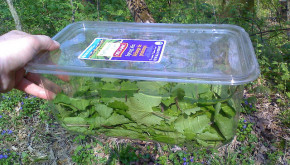
I hope you’ve heard of garlic mustard before, but if not here’s the low down: Garlic mustard was first introduced as a garden herb but escaped and has been causing problems ever since. It is an herbaceous plant that takes two years to reach maturity. Garlic mustard is allelopathic, meaning it produces chemicals that reduce the growth of neighboring plants, so when garlic mustard gets introduced into a site it can quickly outcompete native understory vegetation. Unfortunately it can thrive in fully intact forests. It’s also a prolific seed producer. Each 2-4’ tall, second year plant can produce up to 100 seeds and those seeds remain viable for up to 7 years.
I’m sure you’re wondering what soup has to do with garlic mustard. Remember it was introduced as a garden herb; you guessed it; it’s edible. It makes great pesto but I recently stumbled across a whole garlic mustard cookbook.
- Identify garlic mustard on your land or in your community. This can be done all year round. There are lots of great resources for garlic mustard but my favorite is from the WI DNR.
- Plan a culinary garlic mustard removal event, typically in early May before garlic mustard flowers.
- Gather friends and family or enjoy some quiet time in the woods by yourself and go pull garlic mustard. Be sure to pull up the whole root. There’s often a “J” hook in the root so pulling plants is best done when the soil is soft from rain and with care to get the whole “J” hook. If part of the root remains the plant will likely regrow (much like dandelions).
- Bag the whole plant (you only need to leaves for food, but leaving the roots touching the soil may cause them to reroot and grow again). Ideally you want to get all the plants, but if that’s not possible, take what you need and plan additional management activities.
- After pulling and bagging the plants divide up the plants so everyone can use the leaves for soup and pesto and have a cooking party! (NOTE: Garlic mustard is on the Minnesota Noxious Weed List so transporting seeds or selling the plants is illegal. Everyone must be careful to prevent its spread.) Check out the many garlic mustard recipes from “From Pest to Pesto: Garlic Mustard Eat it to Beat it.” A little more Google searching will yield many more recipes.
- You can always freeze soup and pesto for later.
- Continue garlic mustard management. This one culinary event is very UNlikely to manage your garlic mustard problem. Like most invasives species management this is likely to be a long-term, project that requires several different control methods over several years. Hopefully your soup group is willing to help you manage the garlic mustard for the long term!
The University of Minnesota Extension has as several great resources to help you think about long-term invasive species (and garlic mustard) management, including a great publication on how to prioritize species and how to organize a removal event.
Photo Credits:
Homepage slide for this article by Deb Deppler
Photo of Garlic Mustard Soup by henchminion


